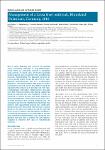Management of a Lassa fever outbreak, Rhineland-Palatinate, Germany, 2016
Ehlkes, Lutz
George, Maja
Samosny, Gerhard
Burckhardt, Florian
Vogt, Manfred
Bent, Stefan
Jahn, Klaus
Zanger, Philipp
Due to rapid diagnosis and isolation of imported cases, community outbreaks of viral haemorrhagic fevers (VHF) are considered unlikely in industrialised countries. In March 2016, the first documented locally acquired case of Lassa fever (LF) outside Africa occurred, demonstrating the disease’s potential as a cross-border health threat. We describe the management surrounding this case of LF in Rhineland- Palatinate – the German federal state where secondary transmission occurred. Twelve days after having been exposed to the corpse of a LF case imported from Togo, a symptomatic undertaker tested positive for Lassa virus RNA. Potential contacts were traced, categorised based on exposure risk, and monitored. Overall, we identified 21 contact persons with legal residency in Rhineland-Palatinate: seven related to the index case, 13 to the secondary case, and one related to both. The secondary case received treatment and recovered. Five contacts were quarantined and one was temporarily banned from work. No further transmission occurred. Based on the experience gained during the outbreak and a review of national and international guidelines, we conclude that exposure risk attributable to corpses may currently be underestimated, and we present suggestions that may help to improve the anti-epidemic response to imported VHF cases in industrialised countries.
Dateien zu dieser Publikation
Keine Lizenzangabe

